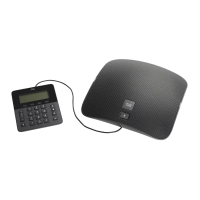•
Cisco Unified Communications Manager user to associate with conference phone
•
Conference phone usage information that affects conference station templates (button and softkey),
features, services, or conference phone applications
Provides a list of configuration requirements for setting up conference phones and identifies preliminary
configuration that you need to perform before configuring individual conference phones, such as conference
phone key button templates or softkey templates. For more information, see the Cisco Unified Communications
Manager System Guide, “Cisco Unified IP Phones” chapter and also refer to Telephony Features Available
for Conference Station.
Step 2
Customize button templates (if required). Allows you to create a custom button template with the Privacy
feature. You can assign this template to shared conference phones so users have access to the Privacy feature.
For more information, see Cisco Unified Communications Manager Administration Guide, “Phone Button
Template Configuration” chapter and Button templates, on page 91.
Step 3
Add and configure the conference phone. Adds the conference phone with its default settings to the Cisco
Unified Communications Manager. For more information, see the Cisco Unified Communications Manager
Administration Guide, “Cisco Unified IP Phone Configuration” chapter. For more information about Product
Specific Configuration fields, refer to the Help in the Phone Configuration window.
Step 4
Add and configure directory number on the conference phone. Adds the directory number and features
associated with the directory number to the conference phone. For more information, see the Cisco Unified
Communications Manager Administration Guide, “Cisco Unified IP Phone Configuration” chapter, “Directory
Number Configuration” and “Creating a Cisco Unity Voice Mailbox” sections, and Telephony Features
Available for Conference Station.
Step 5
Customize softkey templates to add, delete, or change the order of softkey features that display on the conference
phone to meet feature needs. For more information, see the Cisco Unified Communications Manager
Administration Guide, “Softkey Template Configuration” chapter, and Softkey templates, on page 92.
Step 6
(Optional) Assign speed-dial numbers.
Users can change speed-dial settings on their conference phones using the Cisco Unified
Communications Manager User Options web pages.
Note
For more information, see the Cisco Unified Communications Manager Administration Guide, “Cisco Unified
IP Phone Configuration” chapter and Cisco Unified Communications Manager System Guide, “Cisco Unified
IP Phones” chapter.
Step 7
(Optional) Configure conference phone services and assign services.
Users can add or change services on their phones using the Cisco Unified Communications Manager
User Options web pages.
Note
For more information, see the Cisco Unified Communications Manager Administration Guide, “Cisco Unified
IP Phone Services Configuration” chapter, and Services setup, on page 95.
Step 8
Add user information to the global directory for Cisco Unified Communications Manager. For more information,
see Cisco Unified Communications Manager Administration Guide “Add a New User” chapter, Cisco Unified
Communications Manager user addition.
If your company uses a Lightweight Directory Access Protocol (LDAP) directory to store information
on users, you can install and configure Cisco Unified Communications to use your existing LDAP
directory, see Corporate Directory setup.
Note
Step 9
Associate a user to a user group with a conference phone. Provides users with control over their conference
phone such as forwarding calls or adding speed-dial numbers or services.
Some conference phones, such as those in conference rooms, do not have an associated
user.
Note
Cisco Unified IP Conference Phone 8831 Administration Guide for Cisco Unified Communications Manager
9.0
30
Cisco Unified IP Conference Phone 8831
Cisco Unified IP Phone setup in Cisco Unified Communications Manager

